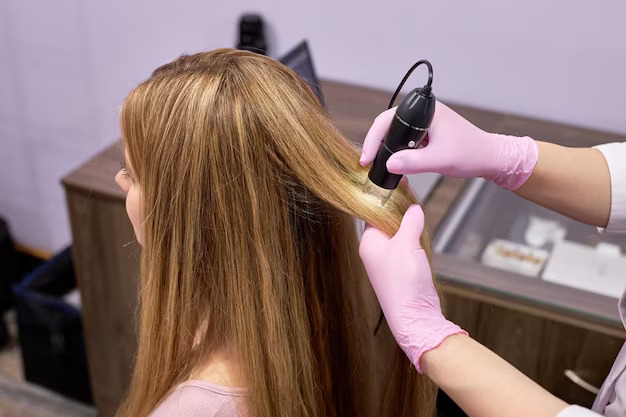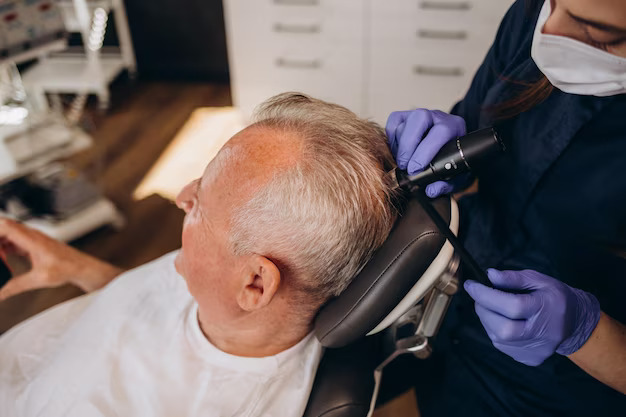English
Hair loss is a common problem that affects millions of people worldwide. Although it may not be life-threatening, it can certainly impact self-esteem and confidence. With the advancement of technology, there is now a cutting-edge tool that can help detect hair loss at its earliest stages–the trichoscope. This innovative device uses high-resolution imaging to magnify the scalp and hair follicles, allowing a specialist to examine the hair and scalp in detail, thereby enabling the detection of hair loss before it becomes visible to the naked eye. Using a trichoscope, hair loss can be accurately diagnosed, and early treatment can be initiated to prevent further hair loss. In this article, we take a closer look at the trichoscope, how it works, and its benefits for the early detection and treatment of hair loss. So, let's dive in!
Understanding Hair Loss and Its Causes
Before discussing the benefits of trichoscopy, it is important to understand the cause of hair loss. Hair loss can occur because of a variety of factors, including genetics, hormonal changes, medication, and stress. Androgenetic alopecia, or male and female pattern baldness, is the most common type of hair loss, affecting millions of people worldwide.
Hair loss occurs when hair follicles shrink, resulting in thinner and shorter strands. Over time, hair follicles become smaller and stop producing new hair, which leads to baldness. Although hair loss is a natural feature of aging, it can also be a symptom of an underlying health condition, such as thyroid disorders or autoimmune diseases.
The Importance of Early Detection
The early detection of hair loss is crucial for preventing further hair loss. Although it is normal to lose up to 100 hairs per day, excessive hair loss can be a sign of problem. If left untreated, hair loss can progress to balance, making it difficult to reverse damage.
The earlier hair loss is detected, the more effective the treatment. Using a trichoscope, hair loss can be accurately diagnosed, and early treatment can be initiated to prevent further hair loss.
Introducing the Trichoscope
Trichoscopeis is a cutting-edge tool used for early detection of hair loss. It uses high-resolution imaging to magnify the scalp and hair follicles, allowing specialists to examine the hair and the scalp in detail. Trichoscopy is a non-invasive, painless procedure that takes only a few minutes to perform.
The trichoscope was equipped with specialized software to analyze the images captured by the device. The software can detect changes in hair density, diameter, and growth patterns, making it possible to accurately diagnose hair loss.
How the Trichoscope Works
Trichoscope uses high-resolution imaging to magnify the scalp and hair follicles. The device emits polarized light that penetrates the scalp and hair, making it possible to see hair follicles in detail. The images captured by the trichoscope were analyzed using specialized software that can detect changes in hair density, hair diameter, and hair growth patterns.
Trichoscopy allows specialists to examine the hair and scalp in detail, making it possible to accurately diagnose hair loss. Using a trichoscope, hair loss can be detected at its earliest stages, making it possible to prevent further hair loss.


There are several benefits to using a trichoscope for hair loss detection. First, the trichoscope allows for early detection of hair loss, making it possible to prevent further hair loss. Second, the trichoscope is a noninvasive, painless procedure that requires only a few minutes to perform. Third, the trichoscope is more accurate than traditional hair loss detection methods such as visual inspection or scalp biopsy.
Trichoscopy is also useful for monitoring the effectiveness of hair loss treatments. By analyzing the images captured by the trichoscope, specialists can determine whether the treatment is effective. If treatment is ineffective, adjustments can be made to ensure optimal results.
Who can benefit from trichoscopy?
Trichoscopy is beneficial to anyone who experiences hair loss. It is particularly useful in patients with androgenetic alopecia, the most common type of hair loss. Trichoscopy can also be used to diagnose other hair and scalp conditions such as alopecia areata, telogen effluvium, and scalp psoriasis.
Trichoscope vs. Traditional Hair Loss Detection Methods
Traditional hair loss detection methods such as visual inspection and scalp biopsy are not as accurate as trichoscopy. Visual inspection relies on the ability of a specialist to detect changes in hair density, diameter, and growth pattern. Scalp biopsy involves removing a small piece of scalp tissue for examination.
In contrast, a trichoscope uses high-resolution imaging to magnify the scalp and hair follicles, allowing specialists to examine the hair and scalp in detail. Trichoscopy is more accurate than traditional hair loss detection methods, making it possible to diagnose hair loss at its earliest stages.
How to Find a Trichoscope Provider?
If you are interested in using a trichoscope for hair loss detection, you can find a trichoscope provider nearby by performing a quick online search. Make sure to choose a provider with a good reputation and experience using a trichoscope.
During your appointment, the specialist will use a trichoscope to examine the hair and the scalp. The images captured by the trichoscope were analyzed using specialized software to diagnose hair loss accurately.
Frequently Asked Questions about the Trichoscope
Q: Is trichoscopy safe?
A: Yes, trichoscopy is a noninvasive, painless procedure that is safe for most people.
Q: How long does a trichoscope appointment take?
A: The trichoscope appointment takes only a few minutes to complete.
Q: Does the trichoscope damage?
A: The trichoscope is a painless procedure that does not require anesthesia.
Q: How accurate is a trichoscope?
A: Trichoscopy is more accurate than traditional hair loss detection methods such as visual inspection or scalp biopsy
Conclusion
Investing in Your Hair Health with the Trichoscope
Hair loss can be a distressing experience; however, with the help of a trichoscope, it is now possible to detect hair loss at its earliest stage. Early detection is crucial for preventing further hair loss and improving treatment outcomes. Trichoscopy is a cutting-edge tool that uses high-resolution imaging to magnify the scalp and hair follicles, allowing specialists to examine them hair and scalp in detail. If you experience hair loss, consider investing in your hair health by using a trichoscope for early detection and treatment.

